Good, greasy, cheap. In Palermo we eat like there's no tomorrow. You get to know Sicily even at the table, during one of the long lunches of the South, endless where you know when they start but not when they end, or even on the street, hastily eating bread with fritters or an arancino (fried filled rice ball) and, for lovers of novelty the sandwich with the spleen.
Sicily is not for those on a diet. I've also tried it at the gates of the summer to face weeks on the road in the hope of losing a few kilos, but the result was the opposite, postponing, thanks a little to the weather not hot enough to parade in bikini, the costume test to a few weeks a little further on.
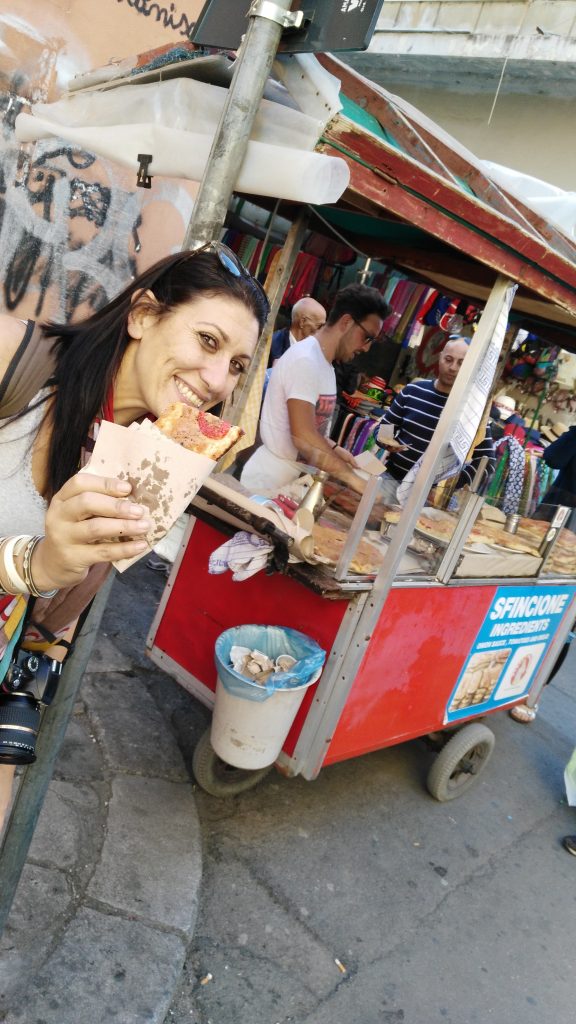
The Sicilian cuisine is strongly linked to dominations that have made Sicily a culturally complex and varied land, pouring in recipes and dishes that have been handed down for thousands of years making culinary delights, more or less complex, a blend of spices, citrus fruits, dried fruits, herbs and flour.
Although the size of the island are not exaggerated what perhaps can leave the palate satisfied is the diversity of cuisine between the different provinces, just move a little to find variants of the same dish or even the total absence of others.
The famous panelle are eaten in Palermo, the busiata in Trapani, the muccunetti in Mazzara del Vallo, the onion pasty in Catania. To summarize some of the many dishes tightly associated with the province. For this reason the Sicilian cuisine is distinguished in the same island in the oriental, central and western cuisine.
Palermo is the regional capital, a city full of markets, historically known the Vucciria that is now a neighborhood in which the market does not exist anymore but is dedicated to night life, and the lively Cape Market and the Ballarò that are tourist destinations on par with the Cathedral or Teatro Massimo .
And it is in the streets that the Palermitan cuisine offers the best of itself, in the stalls or in the LAPE ( three wheelers), in bakeries or in the markets, where for a few Euros you binge yourself full of fried and greasy food at irresistible prices that make the thought of the figure pass into the background.
The best of Palermo street food and some hints about the history of the dishes with reference links to recipes for those who want to engage in the preparation of the dish to impress friends of the NORTH!
Panella, is a pancake made from chickpea flour, usually served as a filling of a roll, the Mafalda, covered in sesame. Often they are consumed with the crocchè, potato croquettes and other fried delicacies, seasoned with salt and lemon.
This dish has Arabic origins. Between the ninth and eleventh century the Arabs begin to grind the seeds of chickpeas to obtain a flour that mixed with water and then cooked over the fire produced a raw and unpleasant tasting dough.
But it did not take long to figure out that a thin layer of this mixture and then fried gave a unique taste, which quickly became one of the delights of the city and its surroundings.
The panella, born in Palermo, dish for the poor to feed themselves at a low cost that today represents the cuisine of Palermo, perhaps more than other dishes.
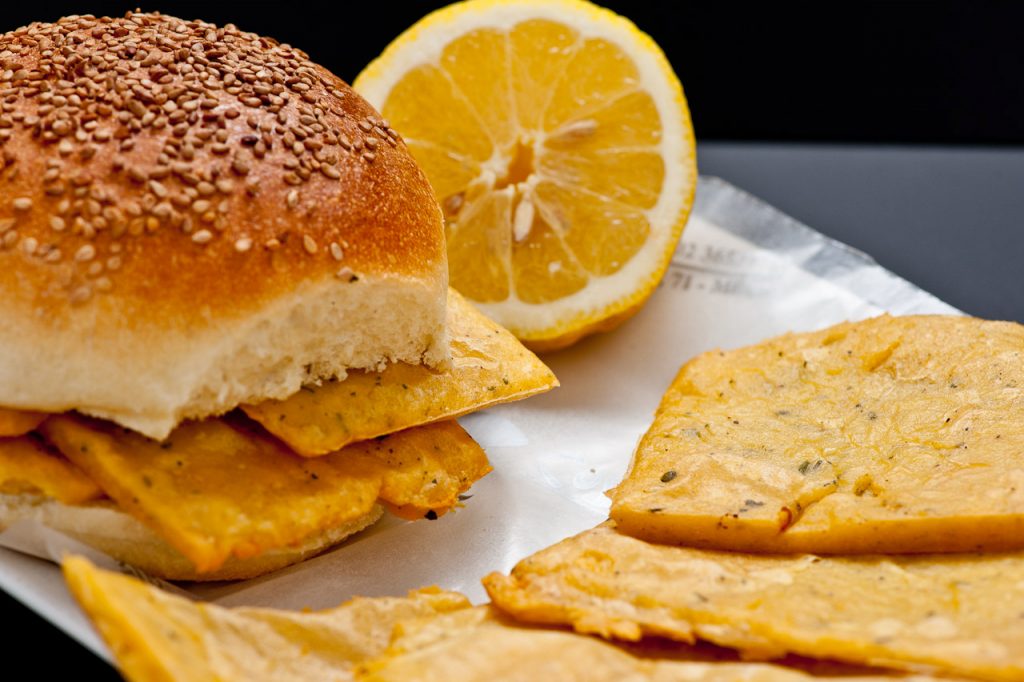
The stigghiola is one of the dishes belonging to the kitchen of the poor which consists of intestines of lamb seasoned with parsley, onion and strung on a skewer or, usually and preferably, rolled around a leek and then cooked over charcoal. Seasoned with salt and lemon. The dish dates back to the Greek cuisine, the so-called kokoretsi ( κοκορέτσι ), a sort of big stigghiola grilled with inside entrails and offal usually of lamb, typical dish of the Easter period.
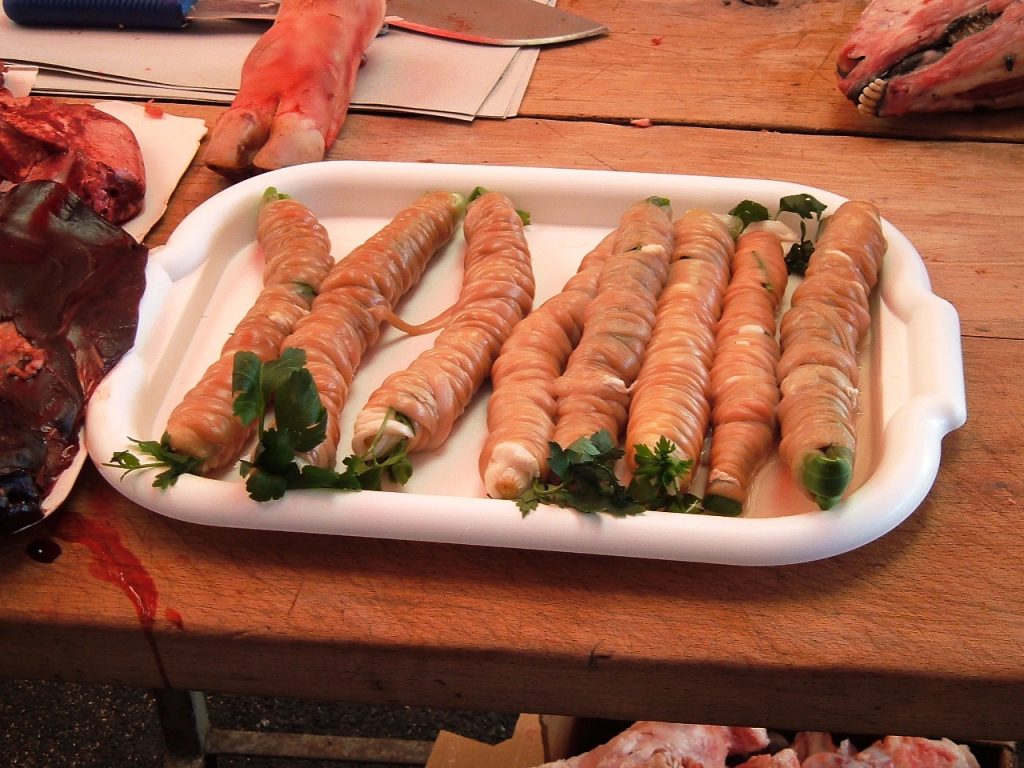
The Sfincione name derives from the Latin spongia and Greek spòngos, σπόγγος, or sponge, or from Arabic اسفنج isfanǧ, term for a pancake dough sweetened with honey.
The Sfincione is an ancient recipe that has as its staple food the pizza bread topped with tomato sauce, onion, anchovies, oregano and small pieces of cheese, usually the caciocavallo cheese. It's a bakery product but the original is bought from the street vendors who sell it on carts with 3 wheels in the streets (on Lapini).
In Bagheria the variant wants it without tomatoes but with tuma or ricotta cheese, onions or anchovies, the so-called white sfincione.
The very idea can make an impression, also the taste certainly the reaction can be of love or hatred, the spleen looks a bit slimy and of strong taste.
But this Palermitan delicacy contained in large quantities in a roll with the caciocavallo cheese variants in addition is a product of excellence of the city and of the province of which the people of Palermo are crazy for. Soft, greasy and dripping the roll with the spleen is worth at least a try.
[su_shadow style="right"][su_panel shadow="none"]
Curiosity - History of Bread with spleen
The Jewish community, this Palermo until 1492, living in a ghetto was devoted to various activities including butchering that they used to exercise in slaughter houses of Palermo. The Palermo slaughter house was today's Cape and the butchery as the sale of the meat took place in the square of the caldumai, the entrails sellers.
Because religion forbade them to be paid for the slaughter in return for work done the butchers kept for themselves the entrails of animals, except for the prized part liver.
To gain something they invented a dish that could be sold, the roll sandwich with the spleen.
Boiled and sterilized the offals, this dish was sold in the streets and had to be eaten with the hands helping with the bread and enriching it with caciocavallo or ricotta cheese. This is how the bread with the spleen came to be, a typical dish that tells how things are done always in necessity, virtue.
[/su_panel][/su_shadow]
I will not dwell on the diatribe on Arancino Vs Arancina, I am from East Sicily and I cannot even pronounce the word ArancinA.
I must also say that I think everything that has to do with gastronomy (arancini, pizzas, onion pasties, white flat bread pizzas etc etc) the supremacy goes to Catania, but, obviously, this delicacy which in any case is found throughout Sicily cannot be amiss in Sicily, and so even in Palermo.
The arancino is a ball or a cone of rice covered in breadcrumbs and fried, the diameter of 8-10 cm, usually stuffed with meat sauce, peas and caciocavallo cheese or diced cooked ham and mozzarella.
The name comes from the original form and the typical golden color reminiscent precisely of an orange, although in eastern Sicily the arancini more often have a conical shape. The secret of good arancino? Crisp on the outside and a creamy paste inside, that, by tradition, should respect the proportions: 2/3 stuffing and 1/3 rice, the practice of which nowadays, little usual and reversed.
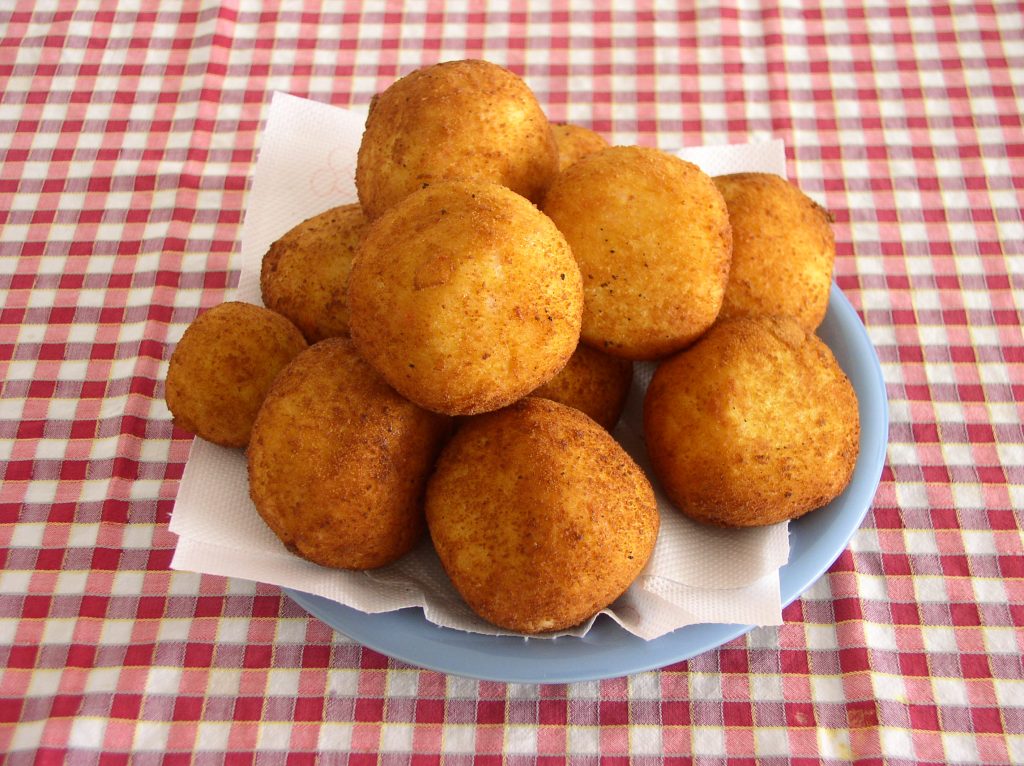
Not to miss out the desserts, the desserts that are worth a lunch, high-calorie contents and filling as if one has eaten a Florentine steak. The cannolo and the cassata do not require too many presentations, but require instead mention of historical references, because perhaps more than for other dishes, it is right in the sweet that one savours the history of Sicily..
I do not think the cannolo with ricotta that must COMPULSORILY be filled on the very moment or the cream, as time passes, will soften the crisp crust that envelopes this delicious preparation, needs too many presentations.
The sweet specialty par excellence known throughout the world, which distinguishes in cannolo and cannolicchio depending on the size, the Cannolo is big and the cannolicchio is small (the one in the picture is a cannolo and to be fair and accurate, in the background is Ragusa).
The origins are Saracens. The ladies of the Harem of the Castle of the Women of the then lord Qalc'at al-Nissa, Caltanissetta, during the long absences of their husbands were used to devote themselves to the preparation of elaborate dishes.
On the basis of an Arab recipe for a sweet made with ricotta cheese, almonds and honey re-elaborated with the Roman recipe mentioned by Cicero have created this sweet today perhaps among the most famous in the world.
At the end of the Norman dominium, the disappearance of the harem, the tradition believes that one of the women converted to Christianity brought with her the recipe in the monasteries not ever letting it die.
A long history starting from the able hands of Muslim women passing to those of Christian sisters to become a typical dessert of the Carnival and then the typical sweet and, at least in my house, of Sunday.
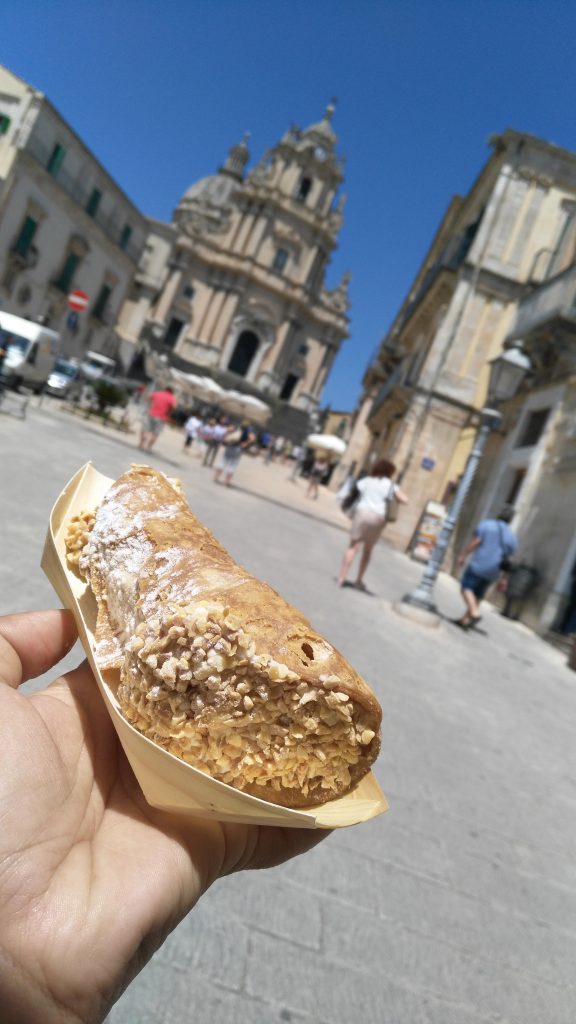
The Sicilian Cassata is a cake made with sweetened ricotta, sponge cake, marzipan and candied fruit.
Seemingly simple recipe, it is instead rather complex and different depending on the province in which it is eaten. This cake has also an interesting history, its origins date back to the Arab domination. The Arabs, in fact, introduced in Sicily the sugarcane, lemon, citron, bitter orange, mandarin, almond. Mixed with the sheep’s milk ricotta, enveloped in a casing of shortbread pastry stuffed with sweetened ricotta and then baked gave rise to the first cassata, cassatina in mono portion dose.
Later in the Norman period, in the convent of the Martorana of Palermo, the royal pasta Martorana was created, a sweet mixture of almond flour and sugar, which, embellished and colored green with herbal extracts, replaced the shortbread pastry as the casing.
The oven-baked cassata became a cold cassata.
Successively the Spanish introduced the chocolate. The candied fruit came in the Baroque period.
It was only in 1876 that this dessert was given a name. Exactly when the confectioner Cavaliere Salvatore Gulì, from Palermo, added to the sweet pumpkin and candied fruits. With the addition of the sugar icing covered with candied fruit that envelopes the sweet as if it was an opaque glass, perhaps, gave birth to the name that is derived from icing becoming frosted, classata and finally Cassata.
A cake that is not only a triumph of taste, but that seems to magnificently represent the history of Sicily in just one forkful.
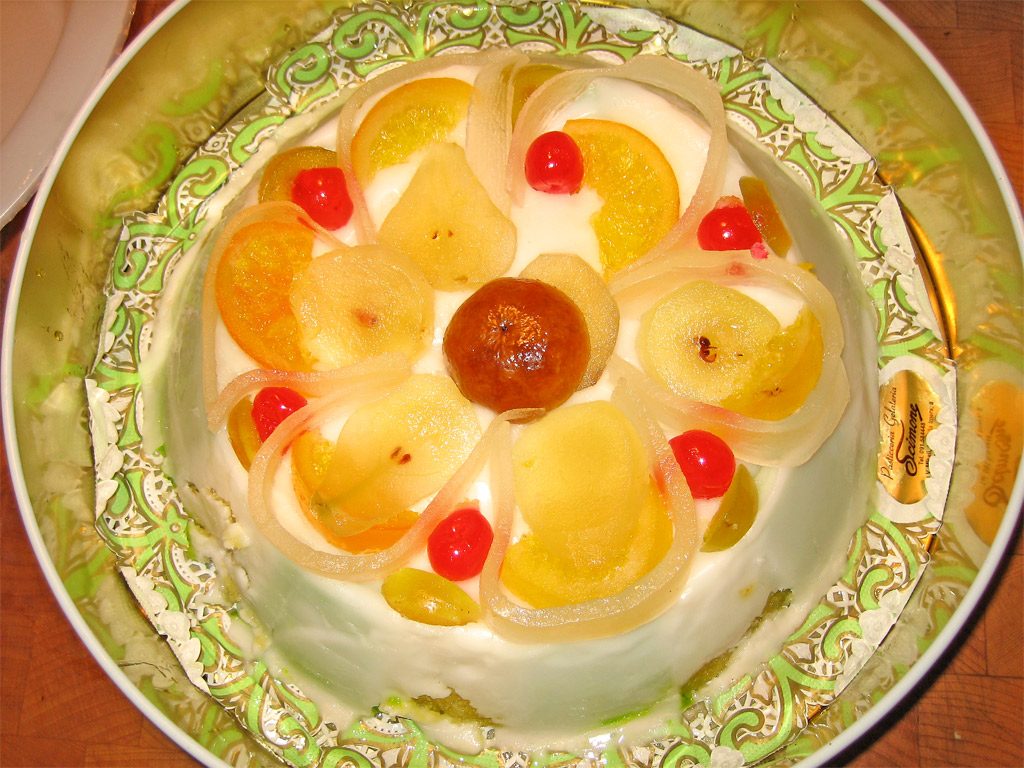
t's true that street food stands for food from the road and, just exactly, you eat on the streets of the city, but there are places that have been recommended to me by many people of Palermo, in particular for the roll sandwich with the spleen, focacceria San Francesco a piazza San Francesco, Antichi Saporti Palermitani, Franco U Vastiddaru a Piazza Marina and Ninu u Ballirinu a Corso Finocchiaro Aprile. In all this I found a nice site voted entirely to the Palermo street food, a social food website , the airbnb of Street food: Crocche.it
A meeting place, which can be a kiosk, a cabin, a noisy three-wheeler, in short, a place in which to share what you eat and leave information to help the next passersby to choose the right place to eat one of the many delicacies of Palermo, discovering the city through its flavors.
For enjoying the Palermo's street food, you might want to check these street food walking tours available: 3 hours street food and historical places walking tour (mixing street food and culture) or the Street food walking tour in Palermo.
Some photos by - mat's eye
Disclaimer: In questo post, alcuni dei link forniti sono link di affiliazione, il che significa che posso guadagnare una commissione se si effettua un acquisto attraverso questi collegamenti. Tuttavia, ciò non comporta nessun costo aggiuntivo per te. Le commissioni che ricevo attraverso questi link di affiliazione aiutano a finanziare e supportare il mio blog, mantenendo così la sua indipendenza e la mancanza di sponsorizzazioni. Mi sforzo sempre di fornirti le migliori informazioni e consigli possibili, basati sulla mia esperienza e ricerca personale. Mi preme sottolineare che il tuo sostegno è fondamentale per mantenere vivo questo blog e continuare a fornirti contenuti di qualità. Grazie per il tuo supporto!
Alcune immagini pubblicate sono state tratte da Internet, nel caso in cui, il loro utilizzo, violasse diritti d’autore, mandateci una mail a [email protected] e verranno immediatamente rimosse.